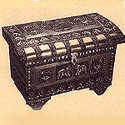Sabai Grass (Botanical name: Eulaliopsis binata Family: Poaceae ( Grass Family) is a tufted perennial grass with basal sheaths woolly with whitish hairs. Locally the fibre or the grass is called Babui Ghash. The grass grows in abundance in the forest fringe areas of Purulia, Bankura and Paschim Medinipore. The Grass is collected by the women and after proper washing and drying the grass is twisted in bundles to form ropes. The Main livelihood is making of ropes and selling it at the local market. Sabai grass is also used in the paper industry. but many artists also make various Sabai based diversified product which has a market at local. Sabai grass is abundant in some pockets of Paschim Medinipur, Purulia and Bankura districts, Around 4000 artists are involved with Sabai Craft in the region.
Process: The grass is first cut and thrashed on the floor properly, to make it soft and easy to be twisted. the next step is to soak the grass in water and keep it for drying. After drying of the grass, they twist it in bundles to form ropes. The ropes are also made through a wheel twisting machine. One operates the machine and another one holds the rope from other side. the ropes formed have rough edges which is then removed after rubbing it on the branches of the trees to remove the extra edges and to make it smooth. Lastly they make the bundle of ropes of about 250 gm, 500 gm and 1 kg.
For making Sabai based products the grass is twisted to actually give shape to a product and dead palm leaf is used to bind the same and also add a proper texture to the product. For many products frames are required to actually give shape to the product. the weave is done around the frame. such frames can be used for floor mats, bags, flower vase etc. The grass and the ropes are also dyed to give colours to different products.


